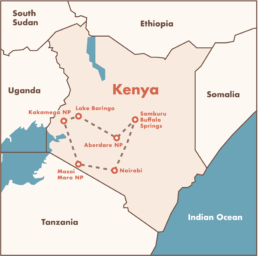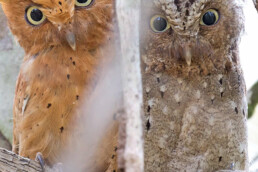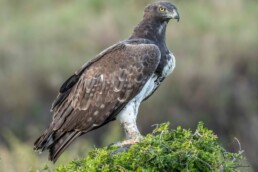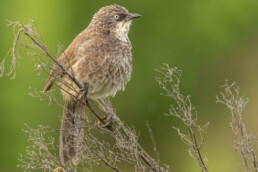Colourful.
Immense.
Stunning.
Kenya is a birding and wildlife paradise, with a stunning array of species and habitats to discover. A birding and wildlife tour in Kenya is the ultimate way to experience the region’s natural beauty and witness some of the world’s most iconic wildlife and avian species.
On this birding expedition to East Africa, we look forward to showing you a wide range of magical species. Prepare yourself for a journey through many exemplary rich habitats bringing you the best birding experiences possible. We will travel to Kenya’s best potential sites in a two-week itinerary. We shall focus on Vulturine Guineafowl, Somali Bee-eater, Blue-headed Bee-eater, the endemic Jackson’s Francolin, and the bright Golden Pipit that will round out this comprehensive trip.

Tour highlights
Four core moments you'll never forget
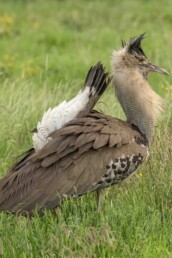
Our classic birding expedition mostly gets close to 500 species of which the East African race of the Kori Bustard is one of the most magnificent.
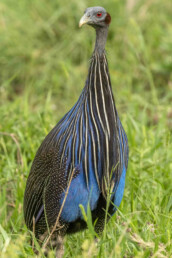
Encounter the prehistoric looking Vulturine Guineafowl. A monotypic and East African endemic found in the dry north of Kenya.
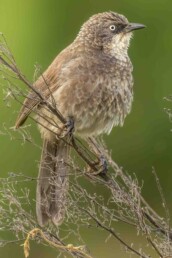
We target many rarities and endemics. We visit the highlands of Central Kenya to find Nanyuki Black-lored Babbler, a Kenyan endemic.
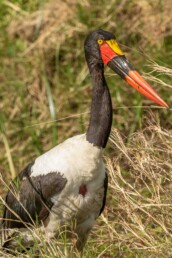
Spent time enjoying the more widespread and common species of Africa, like this dazzling Saddle-billed Stork, seen in the Masai Mara.
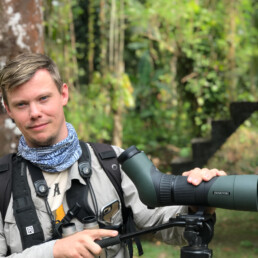
Meet your leader
The expedition is led by Machiel Valkenburg, an experienced photographer, wildlife leader, and world birder. He is simply the best leader available to accompany you on the birding safari of a lifetime. He has been leading birding expeditions all over the Old World with a high level of expertise in Africa and Central Asia. Machiel will provide you with the best experience possible.
Your classic
Kenya itinerary
NIGHT | Day 1, on aircraft.
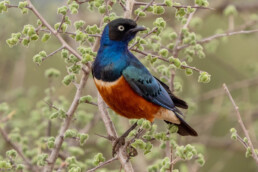
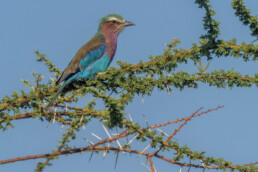
Our “safari” (meaning “journey” in Kiswahili) begins by traveling to Masai Mara with Osero Sopia River Camp as our final destination, located in central Masai Mara. After leaving the hustling city, we find ourselves driving through wheat fields, bush-clad hills, and short-grass plains of the northern part of the ecosystem, on Masai tribal lands. After lunch and settling in at our lovely birding focused lodge, we will make our first game drive in the Mara. The grasslands are right in front of the lodge and often have numerous animals scattered around them. Innumerable amounts of African Buffalo, Common Zebra, Giraffe, or the splendid Greater Kudu are possible within our central located lodge’s vicinity. November is an excellent time of year for migrant raptors and other birds from Eurasia; we will keep an eye open for gorgeous Pallid Harriers patrolling the fields.
In the evening, we enjoy an excursion on our hotel’s grounds and search for the magnificent Verreaux’s Eagle-Owl; close views will reveal its distinct pink eyelids. While searching for the owl, we will be accompanied by guards of the lodge as Hippotamous are feeding on the lush grasslands near the lodge.
We will have two full days of birding and game-viewing in the Mara, a place where we can expect the unexpected. It may be wildebeest racing madly across the plains; or lions at a kill; or hyena’s and vultures cleaning up; or bustards displaying on the open plains; a lone cheetah resting in the shade; or Bat-eared Foxes sunbathing by their den. Maybe it will be a Martial Eagle gorging on prey, or the wild nocturnal scream of the harmless three hyrax, or hippos splashing in the river while a Ross’s Turaco flies past. Almost anything is possible here and our visit is sure to be exciting. With two full days we will have the time to seek out and watch most of the larger mammals, often within close enough range for photography, and still stop to enjoy the diverse birdlife. We have an excellent chance of finding the large cats here
The Mara terrain is varied, and during our time here, we will visit such habitats as short and long-grass plains, open wooded savannah, riverine forest, and dense croton bush. A typical morning in the Mara might look like this; we drive out at dawn after an early breakfast and pick up a perched Martial Eagle while on the other side of the vehicle Little Bee-eaters are foraging heavily. Suddenly we come across a small cackle of Hyenas running along the horizon, we follow in pursuit. They bring us to a Zebra kill, we witness the skirmishes and study the social hierarchy of the Hyenas while hundreds of vultures surround the spectacle, waiting for their turn to finish the job. In the grassland plains we find several Southern Ground-Hornbills strutting along, a Saddle-billed Stork swallows a small frog while a Stout Cisticola is singing loudly. We enjoy some cooling refreshments while a Black-bellied Bustard displays. We drive back for lunch, but suddenly a quick stop shows us a pair of fabulous Cinnamon-breasted Bunting creeping through the grasses, wow, they join a single Rosy-breasted Longclaw! We end the morning visiting the pond near our lodge where forty Hippos are resting!
All big cats possible in Kenya are represented and we will be on the lookout for all. We have outstanding chances on coming across Lion, Leopard and Cheetah. While Serval and Caracal will need some luck to find these smaller cats.
NIGHT | Oserio Soap River Camp, Masai Mara.
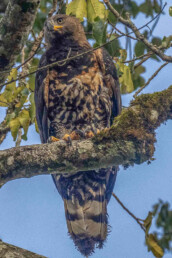
Western Kenya, with its wide altitudinal range and high rainfall, is home to many species of birds not found elsewhere in the country. As we travel across this region we will make select birding stops at tall acacia woodland, marshy streams, and rich farmlands. Our destination is the Kakamega Forest region. This superb mid-elevation rainforest is unique in Kenya, home to a varied and colorful avifauna more typical of Central Africa. We will have a full day to bird this region, with our headquarters at a wonderfully peaceful retreat center located near some of the best remaining forest. Many of the special birds of the area can be found amidst the beautiful grounds.
Kakamega is a true rainforest and exhibits many characteristics that make forest birding both exciting and challenging the world over. Sometimes we must endure long lapses when almost no birds are seen, before suddenly encountering a mixed-flock frantically foraging at all levels, and seemingly containing every bird in the vicinity. Beautiful voices ring from the dense undergrowth, but some of the birds themselves can be difficult to see unless one response to the tape of its calls. Bird diversity is high here, but this also means discouragingly similar species present in the same area (take the eleven species of greenbuls here). We always hope to find a fruiting or flowering tree luring the well-hidden canopy species out into the open; or a driver ant swarm with attendant birds pursuing the fleeing insects.
We should observe the above phenomena, and we will do our best to show you the top birds of the forest. The birding starts already in the excellent (and probably best run lodge of Africa!) garden of our accommodation. Right in the centre in a single tree, we find the massive nest of one of Africa’s best raptors, a female Crowned Eagle is on eggs. Hopefully, we will witness the male bring prey (Blue Monkey) for its hungry partner; the females only periodically leave the nest for a short period. Near the hotel pond, we position us calmly and wait for the superb White-spotted Flufftail to walk by in the early daybreak, a gorgeous rail with white-spotted black upperparts and diagnostic red tail. Overhead we enjoy some loud Black-and-white Casqued Hornbill while a Mackinnon’s Shrike is perched. One of the forest’s top records is the Blue-headed Bee-eater, which we search within the forest interior. The species is regularly seen in Kakamega while other records are from Cameroon or Gabon! Large flocks of foraging birds might include intriguing White-headed Wood-Hoopoe, Gray-throated, Yellow-spotted, Double-toothed and Yellow-billed barbets; Least Honeyguide, Petit’s Cuckoo-Shrike, Black-collared and Buff-throated Apalis, Pink-footed Puffback and four species of Wattle-eyes. Other top birds are the superb Great Blue Turaco (spectacular), fantastic African Emerald Cuckoo, spectacular Red-headed Bluebill (secretive); difficult Vieillot’s, Forest, Brown-capped and Black-billed Weavers; outlandish Red-headed Malimbe; and several Sunbird gems like Green, Western Olive, Green-headed and Green-throated.
Mammals are scarce here, except for squirrels and three entertaining species of monkeys, including the striking Black-and-white Colobus.
NIGHT | Rondo Retreat, Kakamega Forest.
We depart early from Kakamega and set sails for Lake Baringo to arrive in the late afternoon. In the final hours of light, we will bird the famous Baringo cliffs. Here we will focus our expertise on finding a few enigmatic goodies such as Verreaux’s Eagle; here, we also find the eagle’s main prey, some cute Rock Hyrax. Bristle-crowned Starlings are seen from a distance while the very distinctive D’Arnauds and Red-and-yellow Barbets call loudly while cocking their tails from nearby perches. The Brown-tailed Chat will demand some extra time before we can locate this little beauty so will the uncommon Hunter’s Sunbird and rare Magpie Starling.
Furthermore, Northern White-faced Owl, Grayish Eagle-Owl, and Heuglin’s (Three-banded) Courser are hopefully found resting and offer us excellent photographic opportunities. The latter is an exquisite plover found in open sandy clearings in dry Acacia scrub in East Africa. Its underparts are white with an elaborate pattern of black and chestnut stripes and bands. The beautiful Spotted Morning-Thrush is a fine songster with a loud, clear series of powerful variable whistled phrases and seen all around our lodge. More common birds here include White-headed Buffalo-Weavers, Brubru, some small flocks of Blue-naped Moosebird, Golden-backed Weavers, Hemprich’s and Jackson’s Hornbills, Lesser Honeyguide, Parrot-billed Sparrow and Red-faced Crombec. We end the day with a search for Slender-tailed Nightjars.
NIGHT | Sandai Hotel, Baringo.
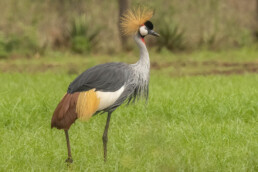
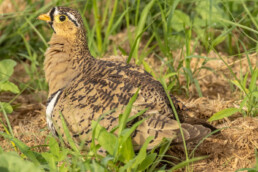
At dawn, we plan an excellent boat trip along the lake’s shores to get close to many birds new for the tour. The first thing we notice is the loud chattering of the Weavers. We need to search some to find the rare and cute Little Weaver. The lake’s water level is rising yearly, and many trees because of it have died, here we find Rufous-crowned Roller perched in the top of the trees making foraging flights for insects. It gives us excellent opportunities to take fantastic imagery of the outstanding African Fish-Eagle. Moreover, in November, a common species is the Blue-cheeked Bee-eater coming from Central Asia, which will provide us with excellent looks. If we are lucky, we will find the dazzling Northern Carmine Bee-eater amongst the migrant bee-eaters. This amazing bee-eater has a carmine-pink body with contrasting beryl-green cheeks, a real beauty! Spectacular Goliath Heron’s and the tiny Malachite Kingfishers are uncommon but mostly seen in small numbers. Good numbers of herons are seen, with Dwarf Bittern being the most attractive one.
In the hotel garden White-bellied Go-Away-Bird, Eastern Violet-backed Sunbird, and Purple Grenadier will get our attention. We spent the second half of the day visiting the Baringo cliffs as we did on day ten.
NIGHT | Sandai Hotel, Baringo.
We plan to make a few interesting stops during our drive from Baringo to the Aberdare Mountains. The most intriguing visit will be at the Equator Monument. At these semi-arid bushlands’ our main goal is to find the elegant Silverbird, a pale bluish-grey bird with uniformly bright rufous underparts, a very striking bird! Other colorful and spectacular possibilities include White-fronted Bee-eater and Fischer’s Lovebirds.
In the afternoon we plan a small walk with the endangered Mackinder Owl as main highlight. When we arrive at the superb Ark Hotel we will do our first exploration of the extended hotel gardens of this exquisite site.
NIGHT | The Ark, Aberdare National Park
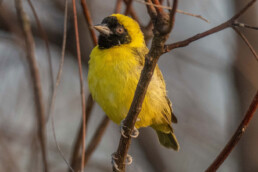
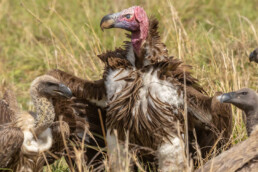
On our full day visit to the mountain range we have an early rise which have us concentrate on spotting the birds of the surrounding montane rainforest and scrub. Many are limited to higher elevations. Here we may see Black Sparrowhawk, Mountain Buzzard, attractive Delegorgue’s and Rameron pigeons, striking Hartlaub’s Turaco, flashy Cinnamon-chested Bee-eater, Silvery-cheeked Hornbill (big and noisy) and vibrant Rüppell’s Robin-Chat. Our activities during the day consist of fruitful walks through the forest (accompanied by an armed guard due to elephants and buffaloes). Here our checklist will increase with gorgeous Tullberg’s Woodpecker, Eastern Mountain-Greenbul, Hunter’s Cisticola, Black-throated Apalis, Cape Wagtail, Golden-winged Sunbird, and Yellow-crowned Canary, among others.
Our excellent local guide will have staked out the secretive Narina Trogon. At the same time, the endemic but locally common Kikuyu White-eye will receive extra focus, a tiny white-eye with a rich green crown and upperparts and a well-defined golden-yellow forehead. Other highlights of the day and new birds for the trip include possible Eastern Bronze-naped Pigeon, Crowned Hornbill, Moustached Tinkerbird, localized Mountain Oriole, White-browed Crombec, responsive Mountain Yellow-Warbler, the nominate Waller’s Kenrick’s and Sharpe’s Starlings. Furthermore, the diminutive Aberdare Cisticola is an endemic to this area and will receive some extra attention. We finish with lovely White-starred Robin, Green-headed and Northern Double-collared Sunbird, Brown-capped Weaver, Gray Apalis, and Red-backed Mannikin. Birding the Aberdare National Park ecosystem will prove to award, and we will enjoy our time thoroughly.
NIGHT | The Ark, Aberdare National Park
NIGHT | Sopa Samburu Lodge, Buffalo Springs.
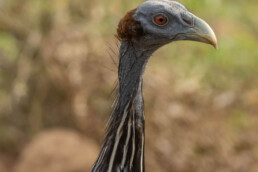
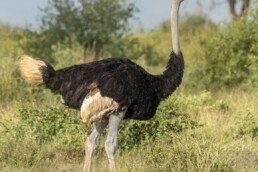
We will have two full days to explore the Samburu National Reserve, the most accessible part of the rugged Northern Frontier. This land of adventure is populated by nomadic herdsmen, various animals, large and small, and a surprising number of birds. Little-known species of the Somali sub-region nest along the dry watercourses, while the mysterious mountain ranges that rise above the arid plains are barely explored. The Uaso Nyiro River and its fringing vegetation assure a continual supply of life-giving water for those creatures that need it. Near-desert conditions prevail away from the river, and the organisms existing here survive long periods without water. Doum palms, contorted acacias, rocky hills, and termite mounds add relief to the open landscape. Samburu is indeed a land of enchantment, reminiscent of the American Southwest.
The abundance of birds in the semi-arid bush is a phenomenon of African birding, and Samburu amply demonstrates this. Typical acacia-bush species are common here and easy to see. There is an excellent opportunity to check over a hundred species of birds in a day. Some of our sightings might include Eastern Chanting-Goshawk; Crested Francolin; Buff-crested Bustard; Black-faced Sandgrouse; Abyssinian Scimitarbill; Eastern Yellow-billed and Von der Decken’s hornbills. Furthermore, Nubian Woodpecker; Taita Fiscal; Slate-colored Boubou; Northern Crombec; Rufous Chatterer; Foxy (Fawn-colored) Lark; Parrot-billed and Chestnut sparrows; Red-billed and White-headed buffalo-weavers and many others get our focus. Less widespread birds usually include the magnificent Secretary-bird, a species known to patrol the open grass savannah in search of prey, killing them with fast kicks with the long legs and stout toes; prey includes poisonous snakes or birds. A definite contender for bird-of-the-trip is the stunning Vulturine Guineafowl. The largest guineafowl in the family has a long slender neck with bare skin on the head; the rich blue underparts and well-developed white and black hackles are outstanding. Another highlight is the gigantic Kori Bustard, the largest flying bird of Africa, regularly seen displaying, a genuinely wonderful experience. The list of rarities and gems is long in these beautiful lands. We hope to find amongst others Red-bellied Parrot; White-headed Mousebird; Somali Bee-eater; Rosy-patched Bushshrike; Golden-breasted, Fischers’s and Magpie starlings; Pink-breasted Lark; the elegant Golden Pipit; Donaldson-Smith’s Sparrow-Weaver; Black-capped Social-Weaver; and Somali Bunting.
Many of these species have ranges restricted to the dry bush country of the Horn of Africa. Raptors ranging in size from the minute Pygmy Falcon to the massive Martial Eagle hunt the area, while flocks of Vulturine and Helmeted guineafowl, sandgrouse, doves, and finches make their way to water daily. The dry Somali region’s unique mammals are found here: the endangered Gravy’s zebra (largest of the wild horses), reticulated giraffe, Beisa oryx, the strange gerenuk (giraffe-antelope), and the diminutive dik-dik. Elephants are a frequent sight, and this is one of the best places in Kenya to see a leopard, the most secretive of the large predators.
NIGHT | Sopa Samburu Lodge, Buffalo Springs.
NIGHT | Comfort tourist hotel in Nairobi.
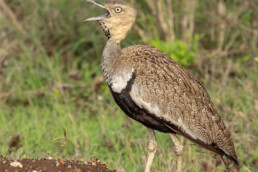
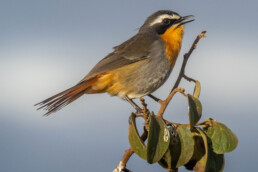
After a splendid birding safari in East Africa, it is time to depart home. We say goodbye from Nairobi International Airport (NBO), from where everybody flies back home.
NIGHT | on aircraft.
- CLICK ON THE IMAGE TO ENLARGE
Next tour
24 November - 09 December, 2024
Cost | $ T.B.A
Single supplement | $ T.B.A.
Deposit | $1000
Group size | minimum 4 and maximum 8
Availability | Spaces
Leader | Machiel Valkenburg
The most all-round expedition
Our classic birding tour takes you along Kenya’s best parks and reserves. The venture is planned during the peak period of the breeding season and simultaneously enjoys the migration of the Palearctic birds. You can expect most species to be in full colorful breeding plumage and actively defending their territories. Many beauty and songs surround us, and ornithological sightings will be abundant. As usual in East Africa, we will encounter much large wildlife during this outstanding birding safari, including cats like cheetahs, lions, or leopards.
In addition to birding and wildlife viewing, our tours offer opportunities to learn about local culture and traditions, enjoy delicious Kenyan cuisine, and relax in comfortable and scenic accommodations.
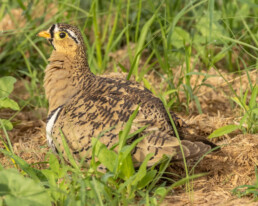
What’s Included?
Expert English-speaking Rubythroat leader
All accommodations
All full-board meals
All land transfers by Landcruiser jeeps
One sundowner at Masai Mara
Visa support
What’s Excluded?
International flight to/from Kenya.
Personal expenses; laundry, telephone costs etc.
Alcoholic drinks.
Extra rooming not mentioned in the itinerary.
Meals on day one.
Single room supplement.
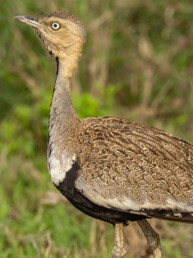
Buff-crested Bustard
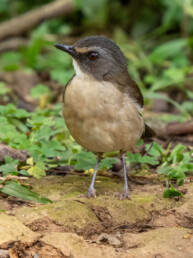
Brown-chested Alethe
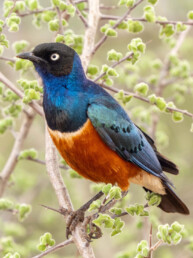
Superb Starling
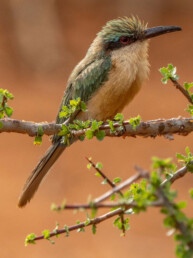
Somali Bee-eater
Ready for your next adventure?
Reserve your spot on our Classic Birding Expedition to Kenya now

